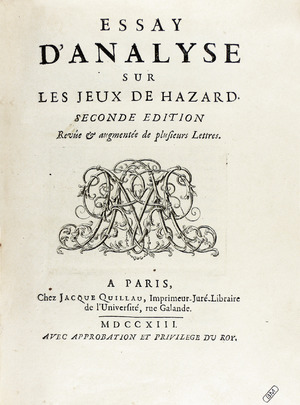Pierre Remond de Montmort facts for kids
Quick facts for kids
Pierre Remond de Montmort
|
|
|---|---|
| Born | 27 October 1678 |
| Died | 7 October 1719 (aged 40) |
| Nationality | French |
| Known for | Works in probability theory |
| Awards | Fellow of the Royal Society |
| Scientific career | |
| Fields | Mathematics |
| Signature | |
Pierre Remond de Montmort was a clever French mathematician. He was born in Paris on October 27, 1678. He passed away in Paris on October 7, 1719. He is well-known for his important work on probability theory. He also helped name Pascal's triangle.
Contents
Who Was Pierre de Montmort?
Pierre's first name was just Pierre Remond. His father wanted him to study law. But Pierre had other plans! He traveled to England and Germany instead. In 1699, he came back to France. He received a lot of money from his father. He used it to buy a big estate. That's when he started using the name "de Montmort."
Friends and Fellow Scientists
Pierre de Montmort became friends with many other famous mathematicians. One special friend was Nicholas Bernoulli. Nicholas visited Pierre's estate. They worked together on math problems there.
In 1715, Pierre traveled to England again. While there, he was chosen as a member of the Royal Society. This is a very old and respected group of scientists. The next year, in 1716, he also joined the French Academy of Sciences.
His Big Ideas in Math
De Montmort is most famous for his book. It was called Essay d'analyse sur les jeux de hazard. This means "Essay on the Analysis of Games of Chance." It was all about probability. Probability is the study of how likely something is to happen.
Probability and Games
His book was one of the first to look at games using combinatorics. This is a part of math that studies different ways to arrange things. He also wrote about "derangements." A derangement is when you arrange items so that none of them end up in their original spot.
Naming Pascal's Triangle
Pierre de Montmort also gave a name to something very famous. He called it "Table de M. Pascal pour les combinaisons." This means "Mr. Pascal's Table for Combinations." Today, we know it as Pascal's triangle. It's a triangle of numbers with many cool patterns. It is used in probability and algebra.
Other Math Interests
De Montmort was also interested in "finite differences." This is a way to study how numbers change in a sequence. In 1713, he figured out a way to add up a certain type of number series. Another mathematician, Goldbach, found the same idea later in 1718.


